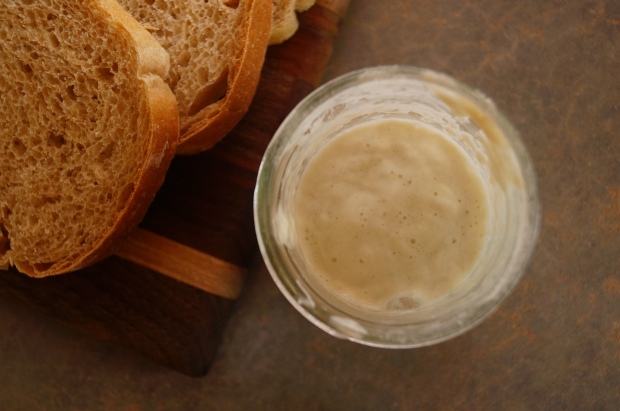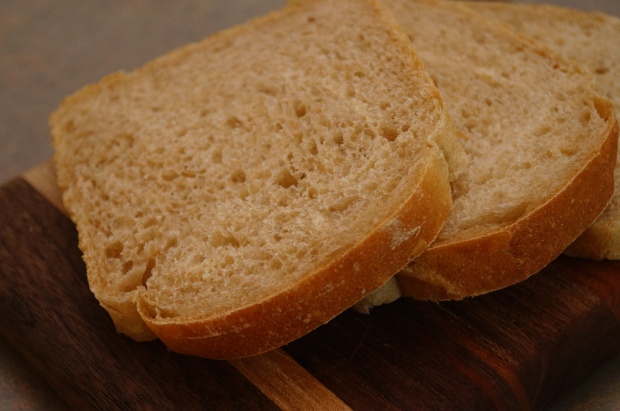I’ve been making bread since I was 12… but recently I decided to play around with Sourdough. I have had quite a few fails, which is a little bit humiliating. I started out with a whole wheat sourdough starter, and we just couldn’t handle how sour the bread was turning out.
So I did some research about how to keep the sourdough tasting sweeter. First I switched it over to unbleached flour (slowly! not all at once.) Then I pour off the hooch, instead of stirring it in. Thirdly, I try to feed it twice a day instead of once a day. Fourthly, it should be a more liquid-y starter… not quite as stiff.

Note: I use a Bosch bread machine… that is what these directions are for. You may have to alter them to fit your situation.
Note #2: I also use commercial sized bread pans… they make 12″ loaves. If you are using regular sized bread pans, this will make FOUR loaves. If you are using a 12″ bread pan, this will make TWO long loaves.
Soft, Mild SOURDOUGH BREAD
1/4 cup Coconut Oil or Butter
1 1/2 cups Milk, room temperature
2 tsp. Instant yeast (this is optional. I’ve done it both ways and it doesn’t make any noticeable difference. It may help shorten rise time but that’s doubtful)
1 T. Salt
2 T. Honey (or bake-ready stevia)
2 cups Sourdough starter, unfed (Click here to read more about sourdough)
2-4 cups Bread Flour (King Arthur or Pillsbury)
2 cups Wheat Flour (King Arthur)
Combine oil, milk, yeast, salt, honey, and sourdough starter in the Bosch mixer. Let sit for ten minutes.
Turn your Bosch mixer on, to the first speed.
Begin adding flour, 1/2 cup at a time. Don’t just dump all the flour in!
Turn the mixer up to second speed when you hear it bog down.
When the dough starts pulling away from the sides of the mixer, and scraping the sides SLIGHTLY clean, stop adding flour.
Cover, and let knead for 10 minutes. Grease a large ceramic or glass bowl.
Stop the mixer, remove your dough hook, and dump the dough into your large ceramic bowl.
Cover with cling wrap and a clean dishtowel. I usually turn on the light in my oven, and place my dishtowel-covered-bowl in there… if you do this, you can skip the cling wrap step.
Let rise for about 2 hours… or until nearly double in size. The rising time varies on temperature and weather… so keep watch on the dough.
To test if the dough is ready to be worked; press your finger gently onto the dough. When the indentation made with your finger springs back slowly, and the dough feels spongy rather than firm, it is ready to be worked.
When risen, dump dough onto lightly floured surface, and knead a few times. It will be slightly sticky.
Divide dough in half. (or in four sections if you are using regular sized bread pans)

Shape into loaves. The best way I’ve found to do this, is to gently shape the dough into an oblong disc, about 2″ thick. Use your fingertips to gently work the dough out. Then fold one half of dough into center, press with your fingers, and bring the other half of the dough into the center. Place your thumbs at the center fold, and give a firm push. This tightens the crumb of the bread and gets rid of most air bubbles. Turn over and shape/stretch/coax into a nice looking loaf.
- 1. Flatten gently with fingers.
- 2. Fold and press gently along folded edge with fingertips.
- 3. Fold other side over. Press along edge firmly with thumbs.
- 4. Flip over so seam is down, then put in pan.
Place in greased pans. Prick tops with a fork if desired. (I don’t always)
Place pans in a warm place (I put them back in the oven with just the light on). Let rise for about an hour, and then check with the fingertip test. Remove from the oven and start preheating to 400 degrees.
It’s better to place the bread in the oven BEFORE it’s done rising, than to wait too long and risk over-rising. Though with Sourdough, I have not had nearly the trouble with rising. It seems to be more stable than bread made with instant yeast.
So stick the bread in the middle to lower rack of the oven… leave space between the pans.
Bake for 20-3o min… or until golden brown and has a hollow sound when tapped.
Turn out onto wire racks IMMEDIATELY! This is important. As the bread cools, steam from the middle works its way toward the crust, causing it to soften. Cooling bread on a rack prevents the bottom crust from getting soggy.
Serve with butter! 😀
I don’t refrigerate my bread… That dries it out. I have had trouble with the last few pieces of my homemade bread getting moldy, but with sourdough, it seems to last much longer on the counter, and this puzzles me! Anyone have wisdom as to why this is?
This sourdough bread is soft, light, tasty, and quite addictive. 🙂






